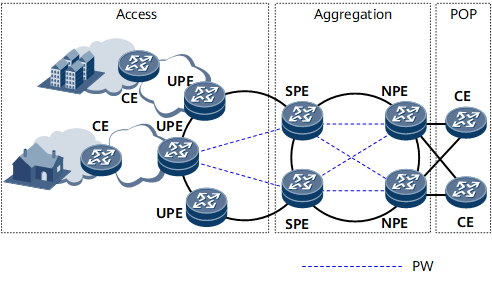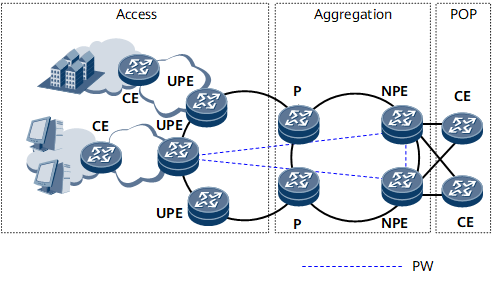Configuring VPLS PW Redundancy
Configuring VPLS PW redundancy improves PW switching efficiency and minimizes the impact of device faults on services.
Usage Scenario
Using VPLS to establish a Metro Ethernet that carries high-speed Internet (HSI), voice over IP (VoIP), Internet Protocol Television (IPTV), mobile backhaul, business applications, and other services has become a trend for large service providers. This trend imposes higher requirements for VPLS reliability. The ME 1.3 solution, also called the VPLS aggregation solution, uses E-VRRP to implement network convergence. Compared with the VPLS PW redundancy solution, the ME 1.3 solution provides higher convergence speed, but has the following disadvantages:
- Some features are Huawei-specific, and therefore cannot be used when Huawei devices communicate with non-Huawei devices.
- Additional configurations, such as mVSIs and mPWs, are required, consuming a lot of network resources.
- PWs cannot be manually switched in the PW protection group on a UPE. PW switching on a UPE can only be triggered by the VRRP switching of NPEs.
- The ME 1.3 solution is complex.
VPLS PW redundancy does not have the preceding disadvantages and is therefore a better way to ensure VPLS reliability.

Only PWE3 VPLS supports PW redundancy.
When configuring VPLS PW redundancy, be sure to configure the primary and secondary PW parameters consistently. Otherwise, the secondary PW may fail to take over services when the primary PW fails.
VPLS PW redundancy has two networking scenarios:
HVPLS: is best suited for multicast services, such as IPTV. This is because service traffic transmitted by CEs at the point of presence (POP) layer are advertised by PEs to all PWs. As HVPLS uses a hierarchical architecture, it requires fewer PWs and less bandwidth between SPEs and NPEs, as compared with common VPLS. Figure 1 shows an HVPLS networking scenario.
VPLS accessing VPWS: is best suited for unicast services, such as HSI, VoIP, and mobile backhaul. When VPWS is configured on NPEs, the NPEs do not need to learn MAC addresses of user terminals. Figure 2 shows a VPLS accessing VPWS networking scenario.
To use VPLS PW redundancy to ensure network reliability, note the following:
- To speed up IPTV service convergence, configure the secondary PW to forward IGMP packets and learn which users join multicast groups.
- If services need to be terminated on PWs and access the Layer 3 network, consider the impact of PW switching on services on the Layer 3 network.
Pre-configuration Tasks
Before configuring VPLS PW redundancy, complete the following tasks:
Configure IP addresses and an Interior Gateway Protocol (IGP) on PEs.
Establish public network tunnels between PEs.
The public network tunnels can be:
LDP LSPs: To establish LDP LSPs, enable MPLS and MPLS LDP both globally and per interface on each node of the public network. If two PEs are indirectly connected, establish a remote LDP session between them.
TE tunnels: To establish TE tunnels, enable MPLS, MPLS TE, and RSVP-TE globally and per interface on each node of the public network, and enable CSPF in the MPLS view of the ingress of each tunnel to be created.

Because pseudo wire emulation edge-to-edge (PWE3) uses LDP to assign VPN labels, you must globally enable MPLS LDP on PEs and establish MPLS LDP sessions if TE tunnels are used as public tunnels.
If the public tunnels are not LDP LSPs, you must configure tunnel policies and apply them to these public tunnels.
Enable MPLS L2VPN on PEs.
- Configuring a PW
- LDP PWs can be configured in hierarchical virtual private LAN service (HVPLS) or (virtual private LAN service) VPLS accessing virtual private wire service (VPWS) networking scenarios.
- Adding PWs to a PW Protection Group
- After configuring PWs, add them to a PW protection group, specify PW priorities, and configure PW protection group parameters to implement PW redundancy.
- (Optional) Associating the Spoke PW Status with Hub PW Status
- After the spoke PW status is associated with the hub PW status, the spoke PW will go Down if the associated hub PWs go down, triggering an active/standby spoke PW switchover.
- (Optional) Configuring BFD for PW
- After configuring PWs, configure BFD for PW to detect the faults of the primary PW to speed up fault detection and improve PW switching performance.
- (Optional) Manually Switching PWs in a PW Protection Group
- In PW maintenance, you can manually switch services to the standby PW to facilitate maintenance operations.
- Verifying the VPLS PW Redundancy Configuration
- After configuring VPLS PW redundancy, check information about the PW protection group of a specified VSI, PWs in the PW protection group, and LDP VCs in the PW protection group.

